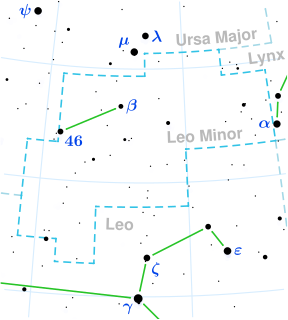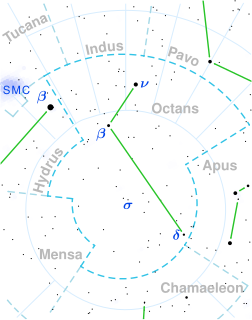
Rho1 Sagittarii, Latinized from ρ1 Sagittarii, is a single, variable star in the southern constellation of Sagittarius. It has a white hue and is visible to the naked eye with an apparent visual magnitude that fluctuates around 3.93. The distance to this star is approximately 127 light years based on parallax, and it is drifting further away with a radial velocity of +1.2 km/s. It is positioned near the ecliptic and so it can be occulted by the Moon.

ι Sculptoris, Latinized as Iota Sculptoris and abbreviated iot Scl, is a solitary star in the southern constellation of Sculptor. It is visible to the naked eye as a dim, orange-hued point of light with an apparent visual magnitude of 5.18. The star is located approximately 336 light years from the Sun based on parallax, and is drifting further away with a radial velocity of +21 km/s.

μ Sculptoris, Latinized as Mu Sculptoris, is a solitary, orange-hued star in the southern constellation of Sculptor. It is visible to the naked eye as a dim point of light with an apparent visual magnitude of +5.30. This star is located approximately 291 light years from the Sun based on parallax, and it is drifting further away with a radial velocity of +16 km/s.

4 Sagittarii is a suspected astrometric binary star system in the zodiac constellation of Sagittarius, located approximately 390 light years away based on parallax. It is visible to the naked eye as a faint, blue-white hued star with an apparent visual magnitude of 4.74, The system is moving closer to the Earth with a heliocentric radial velocity of −18 km/s.

HR 6801 is a single star in the southern zodiac constellation of Sagittarius. It was designated as 1 Sagittarii by Flamsteed, but is now often referred to as 11 Sagittarii. Flamsteed's 11 Sgr actually refers to a different, much fainter star. The object is orange in hue and is visible to the naked eye as a faint point of light with an apparent visual magnitude of 4.96. The distance to this star is approximately 258 light years based on stellar parallax, and it is drifting further away with a radial velocity of +6 km/s.

10 Leonis Minoris is a single, variable star in the northern constellation Leo Minor, located approximately 180 light years away based on parallax. It has the variable star designation SU Leonis Minoris; 10 Leonis Minoris is the Flamsteed designation. This body is visible to the naked eye as a faint, orange-hued star with a baseline apparent visual magnitude of 4.54. It is moving closer to the Earth with a heliocentric radial velocity of −12 km/s.

18 Monocerotis is a binary star system located about half way from Orion's Belt to Procyon, in the equatorial constellation of Monoceros. It is visible to the naked eye as a faint, orange-hued star with an apparent visual magnitude of 4.47, and is positioned around 370 light years away from the Sun based on parallax. The system is receding from the Earth with a heliocentric radial velocity of +11 km/s.
28 Monocerotis is a single star in the equatorial constellation of Monoceros. It has an orange-hue and is faintly visible to the naked eye with an apparent visual magnitude of 4.69. The distance to this star is approximately 450 light years based on parallax, and it has an absolute magnitude of −1.00. The star is drifting further away from the Sun with a radial velocity of +26.7 km/s.

17 Monocerotis is a single star located around 490 light years away from the Sun in the equatorial constellation of Monoceros. It is visible to the naked eye as a faint, orange-hued star with an apparent visual magnitude of 4.77. The star is moving away from the Earth with a heliocentric radial velocity of +46 km/s.

3 Monocerotis is a binary star system in the equatorial constellation of Monoceros, located approximately 780 light years away from the Sun based on parallax. It is visible to the naked eye as a faint, blue-white hued star with a combined apparent visual magnitude of 4.92. The system is moving further from the Earth with a heliocentric radial velocity of +39 km/s.
27 Monocerotis is a single star located about 318 light years away from the Sun star in the equatorial constellation of Monoceros. It is visible to the naked eye as a faint, orange-hued star with an apparent visual magnitude of 4.93. The star is advancing toward the Earth with a heliocentric radial velocity of −28 km/s.

71 Ophiuchi is a single star in the equatorial constellation of Ophiuchus. It is visible to the naked eye as a faint, yellow-hued point of light with an apparent visual magnitude of 4.64. The star is located approximately 273 light years away from the Sun based on parallax, and is moving closer with a radial velocity of −3 km/s.

24 Scorpii is a star that was originally placed by John Flamsteed within the constellation of Scorpius but in now placed within the southeastern constellation of Ophiuchus. It is visible to the naked eye as a faint, yellow-hued point of light with an apparent visual magnitude of 4.91. Based on the trigonometric parallax published in Gaia Data Release 2, the star lies approximately 121 parsecs or 390 light years away. It is positioned near the ecliptic and thus is subject to lunar occultations.

31 Orionis is a binary star system in the equatorial constellation of Orion, located near the bright star Mintaka. It is visible to the naked eye as a faint, orange-hued point of light with a baseline apparent visual magnitude of 4.71. The distance to this system is approximately 490 light years away based on parallax, and it is drifting further away with a mean radial velocity of +6 km/s.

51 Orionis is a single star in the equatorial constellation of Orion. It has the Bayer designation b Orionis, while 51 Orionis is the Flamsteed designation. This object is visible to the naked eye as a faint, orange-hued star with an apparent visual magnitude of 4.90. It is located approximately 299 light years away from the Sun based on parallax, and is drifting further away with a radial velocity of +88 km/s.

π Pavonis, Latinized as Pi Pavonis, is a candidate astrometric binary star system in the constellation Pavo. It is a white-hued star that is visible to the naked eye as a faint point of light with an apparent visual magnitude of 4.33. The distance to this object is 130 light years based on parallax, but it is drifting closer to the Sun with a radial velocity of −15.6 km/s.

ξ Pavonis, Latinized as Xi Pavonis, is a triple star system in the southern constellation of Pavo. It is visible to the naked eye as a faint star with a combined apparent visual magnitude of 4.35 The system is located approximately 440 light years from the Sun based on parallax, and it is drifting further away with a radial velocity of +12 km/s.

54 Persei is a single star in the northern constellation of Perseus. It is visible to the naked eye as a faint, yellow-hued star with an apparent visual magnitude of 4.93. The star is located approximately 220 light years away based on parallax, but is drifting closer with a radial velocity of −27 km/s.

24 Persei is a star in the northern constellation of Perseus, located around 337 light years from the Sun. It is visible to the naked eye as a faint, orange-hued star with an apparent visual magnitude of 4.94. The object is moving closer to the Earth with a heliocentric radial velocity of −37 km/s.

λ Octantis, Latinized as Lambda Octantis, is a binary star system in the southern circumpolar constellation of Octans. It is visible to the naked eye as a dim point of light with a combined apparent visual magnitude of 5.27. The distance to this system is approximately 398–409 light years, based on parallax, but it is moving closer with a radial velocity of −10 km/s.









